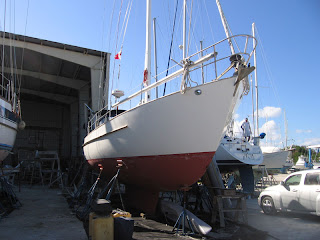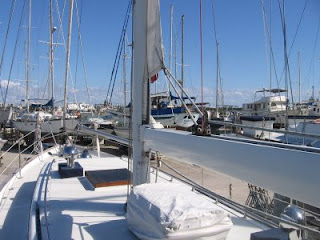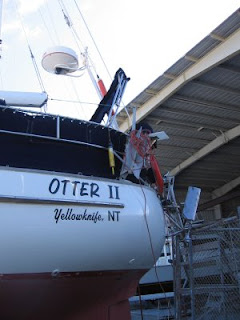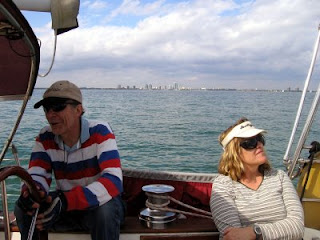 On the Saturday while I was in Miami, I drove up to Fort Pierce to meet with Stan Dabney and take a look at a Valiant 40 sailboat he had listed through his brokerage, Offshore Atlantic Yachts, Inc. Stan is one of the founders of Valiant Yachts, and no one knows that boat or its history better than he does. The boat we looked at was Otter II, a 1979 centerboard model that is currently owned
On the Saturday while I was in Miami, I drove up to Fort Pierce to meet with Stan Dabney and take a look at a Valiant 40 sailboat he had listed through his brokerage, Offshore Atlantic Yachts, Inc. Stan is one of the founders of Valiant Yachts, and no one knows that boat or its history better than he does. The boat we looked at was Otter II, a 1979 centerboard model that is currently owned  by Bruce and Phyllis from Yellowknife in the Northwest Territories. They had just spent thirty days sailing up from Panama, and Phyllis, who was on hand to show the boat, said they had taken a pounding beating upwind in heavy seas. You wouldn't have known it to look at the boat, which was in immaculate condition. I had studied the listing on YachtWorld.com carefully, but text and photos didn't do her justice.
by Bruce and Phyllis from Yellowknife in the Northwest Territories. They had just spent thirty days sailing up from Panama, and Phyllis, who was on hand to show the boat, said they had taken a pounding beating upwind in heavy seas. You wouldn't have known it to look at the boat, which was in immaculate condition. I had studied the listing on YachtWorld.com carefully, but text and photos didn't do her justice. Coming directly from the Caouettes' Valiant 40, which is crammed to the gills with stuff, Otter II looked almost austere. In place of the standard teak, there was light-colored Formica on most of the vertical surfaces, which brightened the interior dramatically. The original plastic hatches had been replaced with steel ones and the woodwork was freshly varnished, making the boat shine all the more.
Coming directly from the Caouettes' Valiant 40, which is crammed to the gills with stuff, Otter II looked almost austere. In place of the standard teak, there was light-colored Formica on most of the vertical surfaces, which brightened the interior dramatically. The original plastic hatches had been replaced with steel ones and the woodwork was freshly varnished, making the boat shine all the more.  The navigation station was nicely laid out and well organized. There was an SSB radio but Phyllis said they had not had success with getting it set up for use with email. The radar screen could be viewed easily from both the station and the cockpit.
The navigation station was nicely laid out and well organized. There was an SSB radio but Phyllis said they had not had success with getting it set up for use with email. The radar screen could be viewed easily from both the station and the cockpit.One feature I was curious about but couldn't figure out from the listing was the centerboard's workings. The Valiant 40's off-center companionway allows the cable that raises and lowers the centerboard to run through the boat's centerline, making it relatively unobtrusive. There is a separate steel pipe next to the one that acts to connect the deck to the hull just aft of the mast. Where that pipe meets the cabin ceiling, there is a teak box containing a block which
 redirects the cable coming through the pipe to a winch located at the cockpit bulkhead. According to Phyllis, it takes exactly thirty turns of the winch handle to completely raise or lower the centerboard; there is no easy way to gauge its intermediate positions. The listing showed photos of the boat hauled out, with the centerboard partially lowered, but in the boatyard where she is now
redirects the cable coming through the pipe to a winch located at the cockpit bulkhead. According to Phyllis, it takes exactly thirty turns of the winch handle to completely raise or lower the centerboard; there is no easy way to gauge its intermediate positions. The listing showed photos of the boat hauled out, with the centerboard partially lowered, but in the boatyard where she is now  sitting, the boat is resting on her keel with the centerboard fully raised.
sitting, the boat is resting on her keel with the centerboard fully raised.There were several nice features topsides. The mast-furled mainsail is operated electrically, making reefing as simple as pushing a button. There is a small crane for raising and lowering the heavy dinghy outboard and for moving heavy items like fuel tanks and batteries in and out of the boat. The cockpit has a nicely designed folding binnacle table, a propane barbecue on the stern rail and a booster step behind the wheel for extra height when looking over the dodger.
 The only negative aspect of Otter II is that she is a "blister boat," one of the Valiant 40s built by Uniflite between 1976 and 1981 that have a blistering problem in the fiberglass laminates. Stan pointed out the many small blisters on the hull and even chipped off a few with his thumbnail. They are more cosmetic than structural and can be repaired by stripping off and replacing the outer layers of fiberglass. Stan said that this is an expensive and unpredictable process in the United States but that when President Obama loosens restrictions with Cuba, it could probably be done there for about $5000, with a higher quality result. In addition to the blisters on their hulls, blister boats usually have blisters on their decks but there were none visible, so it is possible that
The only negative aspect of Otter II is that she is a "blister boat," one of the Valiant 40s built by Uniflite between 1976 and 1981 that have a blistering problem in the fiberglass laminates. Stan pointed out the many small blisters on the hull and even chipped off a few with his thumbnail. They are more cosmetic than structural and can be repaired by stripping off and replacing the outer layers of fiberglass. Stan said that this is an expensive and unpredictable process in the United States but that when President Obama loosens restrictions with Cuba, it could probably be done there for about $5000, with a higher quality result. In addition to the blisters on their hulls, blister boats usually have blisters on their decks but there were none visible, so it is possible that  the decks had been repaired at some point but I didn't get a chance to ask Phyllis for the details.
the decks had been repaired at some point but I didn't get a chance to ask Phyllis for the details.All in all, Otter II is an excellent boat and an excellent value at an asking price of $95,000. These current economic conditions favor the buyer over the seller, but Stan says that sales have been especially slow in the last few months as people wait to see if the recession has bottomed out or if it will continue into the foreseeable future. If things turn around before too long and Otter II is still available, who knows what might happen?

 Raising Charlie: The Lessons of a Perfect Dog
Raising Charlie: The Lessons of a Perfect Dog






